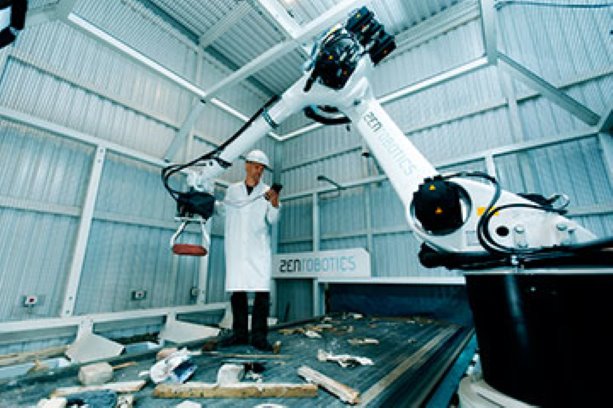Let’s get it straight right up front. The new automated construction and demolition waste sorting system, the ZenRobotics Recycler (ZRR), is NOT a robot.
“ZenRobotics makes recycling systems,” says Rainer Rehn, the Finnish company’s chief commercialization officer.
“One part of the product is indeed an industrial robot, but we don’t manufacture it.”
What the company does offer is a full-blown waste processing system, assembled from off-the-shelf industrial robotic components, that can efficiently pick through the construction and demolition waste stream, sorting materials by type. The robot component forms less than 10 per cent of the system by weight — just one component among dozens.
Construction and demolition waste is initially placed on a conveyor belt.
“ZenRobotics Recycler then utilizes a number of high-tech sensors to inspect the waste stream,” says Rehn.
“It’s a very accurate sorting system in terms of material recognition.”
One of the more advanced sensing systems used by the ZRR is a spectrometric absorption camera which identifies the composition of objects. It’s augmented by a 3D laser scanning system that supplies information on object shape and volume. More traditional devices used in the system include a good-old fashioned metal detector and visible spectrum cameras.
“The vast stream of sensory data is fed to the ZenRobotics Brain control system, which applies an adaptive artificial intelligence algorithm to identify materials and deduce the current-best picking sequence,” says Rehn.
“That minimizes the need for manual calibration.”
The robotic arm then grabs valuable material and drops it into specific hoppers to be reclaimed, re-used or sold.
Studies of the system have indicated that ZRR becomes more economical than using human sorters after about a year of operation.
“For one, the ZRR system is tireless and requires very little maintenance, potentially allowing 24/7 waste processing,” says Rehn.
“The ZRR can also be used to identify and sort materials that humans cannot reliably tell apart — various polymers and plastics for example. Furthermore, humans are rather fragile and susceptible to contaminants, chemicals, heavy or sharp items, dust, heat and cold,” he explained.
“The inherently human tendency to avoid heavy or monotonous tasks means that human sorters are not a long-term answer to the global challenge of raw materials recovery. Manual sorting doesn’t seem to have a future.”
The ZRR is available in two models, the ZRR Heavy Picker for objects up to 20 kgs, and the ZRR Fast Picker system for objects up to five kgs.
The ZRR pilot plant has been in operation since 2011 at SITA Finland, a part of Suez Environnement. The system sorts materials for two shifts per day.
A recent $17-million venture capital investment has allowed the company to offer the system for sale in about 50 countries, including Canada. The first customer deliveries of the units, to Belgium and Holland, are scheduled for early 2013.
“Although we’re partial to calling it ‘the most promising cure to the waste and raw material crisis,’ remember not to refer to it as a robot,” says Rehn.
“That really impresses us — and you should try to impress us, as we’ll be the last to go when the machines really do take over.”



Recent Comments
comments for this post are closed